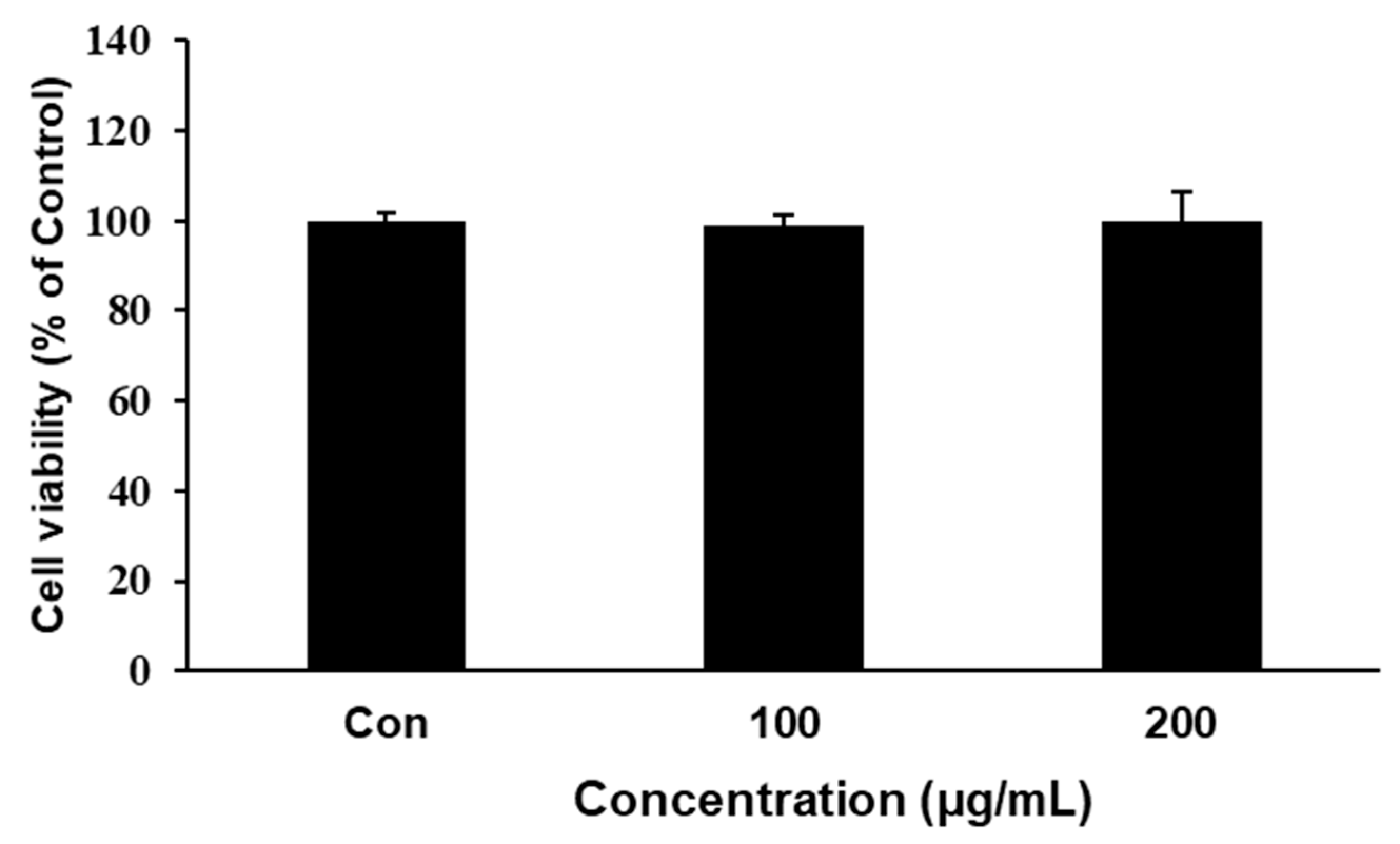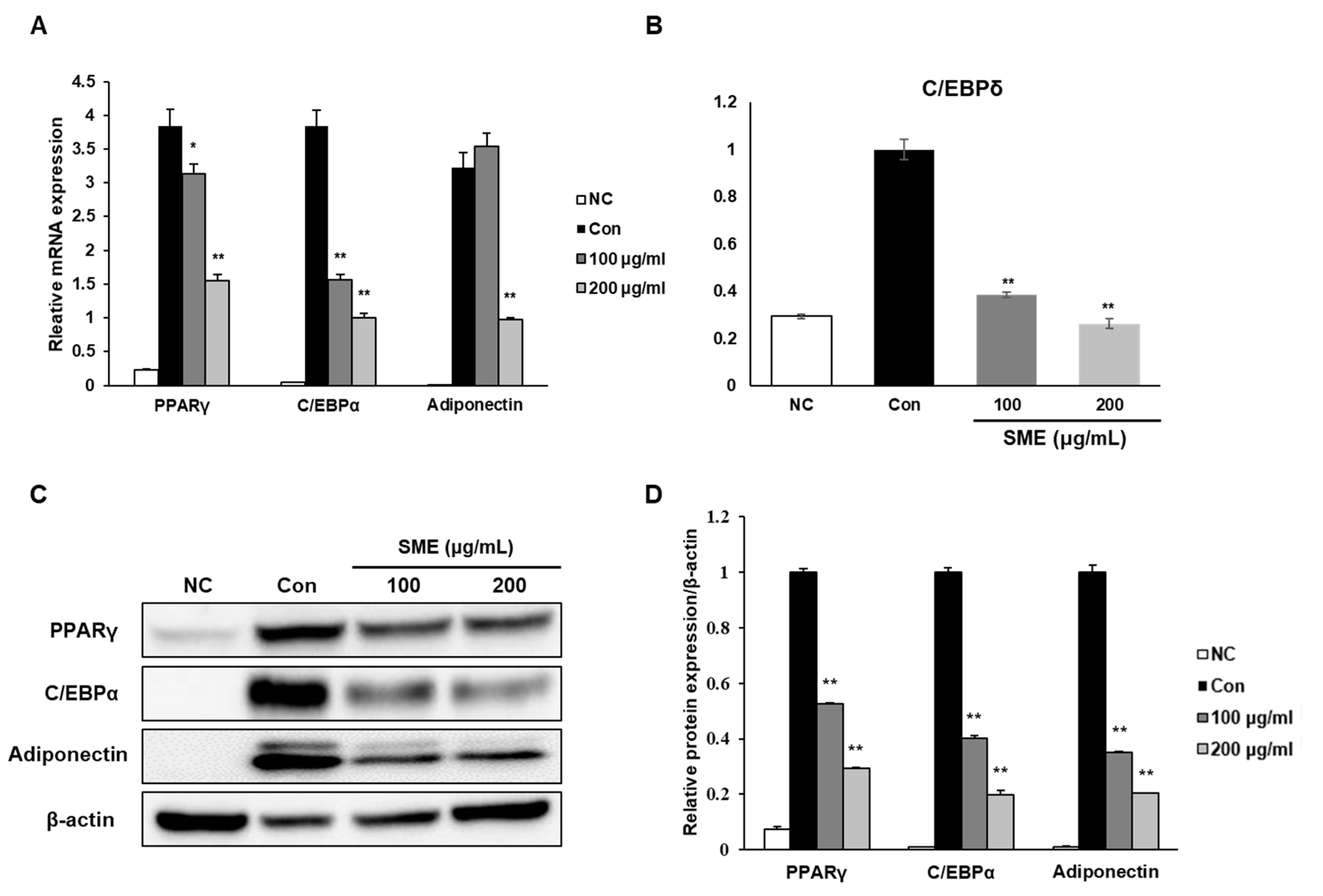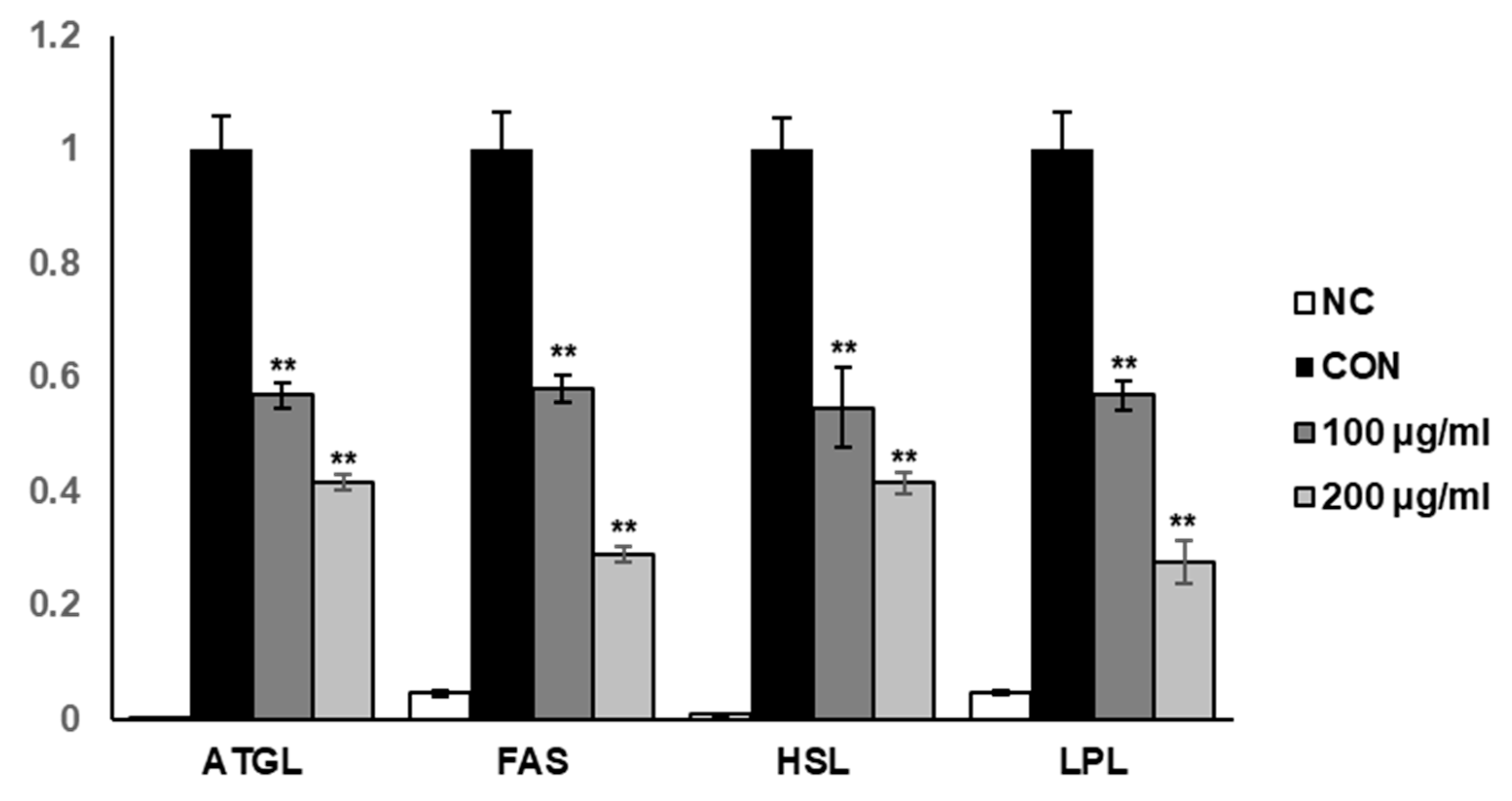Sargassum miyabei Yendo Brown Algae Exert Anti-Oxidative and Anti-AdipogenicEffects on 3T3-L1 Adipocytes by Downregulating PPARγ
Abstract
:1. Introduction
2. Materials and Methods
2.1. Sample Preparation
2.2. Chemicals
2.3. Antioxidant Analysis
2.3.1. 2,2-diphenyl-1-picrylhydrazyl (DPPH)
2.3.2. 2,2’-azinobis-3-ehtlbezothiazoline-6-sulfonic Acid Radical Decolorization (ABTS)
2.4. Cell Culture
2.5. Adipocyte Differentiation and Drug Treatment
2.6. Cell Viability Assay
2.7. Oil Red O Staining
2.8. Triglyceride Assay
2.9. Real-Time Reverse Transcription Polymerase Chain Reaction (RT-PCR)
2.10. Western Blot Assay
2.11. Statistical Analysis
3. Results
3.1. Antioxidant Activity
3.2. Effects of SME on 3T3-L1 Preadipocyte Cell Viability
3.3. SME Effects on Lipid Accumulation and Triglyceride Composition in 3T3-L1 Adipocytes
3.4. Effects of SME on Adipogenesis-Related Gene Expressions during 3T3-L1 Cell Differentiation
3.5. Effects of SME on Lipogenic-Related Gene Expressions on 3T3-L1 Adipocytes
4. Discussion
5. Conclusions
Author Contributions
Funding
Conflicts of Interest
References
- Deurenberg, P.; Yap, M. The assessment of obesity: Methods for measuring body fat and global prevalence of obesity. Baillieres Best Pract. Res. Clin. Endocrinol. Metab. 1999, 13, 1–11. [Google Scholar] [CrossRef] [PubMed]
- Bluher, M. Adipose tissue dysfunction contributes to obesity related metabolic diseases. Best Pract. Res. Clin. Endocrinol. Metab. 2013, 27, 163–177. [Google Scholar] [CrossRef] [PubMed]
- Ruiz-Ojeda, F.J.; Ruperez, A.I.; Gomez-Llorente, C.; Gil, A.; Aguilera, C.M. Cell Models and Their Application for Studying Adipogenic Differentiation in Relation to Obesity: A Review. Int. J. Mol. Sci. 2016, 17, 1040. [Google Scholar] [CrossRef] [PubMed] [Green Version]
- Armani, A.; Mammi, C.; Marzolla, V.; Calanchini, M.; Antelmi, A.; Rosano, G.M.; Fabbri, A.; Caprio, M. Cellular models for understanding adipogenesis, adipose dysfunction, and obesity. J. Cell Biochem. 2010, 110, 564–572. [Google Scholar] [CrossRef]
- Padwal, R.S.; Majumdar, S.R. Drug treatments for obesity: Orlistat, sibutramine, and rimonabant. Lancet 2007, 369, 71–77. [Google Scholar] [CrossRef]
- Mohamed, G.A.; Ibrahim, S.R.M.; Elkhayat, E.S.; El Dine, R.S. Natural anti-obesity agents. Bull. Fac. Pharm. Cairo Univ. 2014, 52, 269–284. [Google Scholar] [CrossRef] [Green Version]
- Meydani, M.; Hasan, S.T. Dietary polyphenols and obesity. Nutrients 2010, 2, 737–751. [Google Scholar] [CrossRef]
- Bahmani, M.; Eftekhari, Z.; Saki, K.; Fazeli-Moghadam, E.; Jelodari, M.; Rafieian-Kopaei, M. Obesity phytotherapy: Review of native herbs used in traditional medicine for obesity. J. Evid. Based Complement. Altern. Med. 2016, 21, 228–234. [Google Scholar] [CrossRef]
- Umezaki, I. Ecological studies of Sargassum miyabei YENDO in Maizuru Bay, Japan Sea. Nippon Suisan Gakkaishi 1983, 49, 1825–1834. [Google Scholar] [CrossRef]
- Kang, H.S.; Chung, H.Y.; Kim, J.Y.; Son, B.W.; Jung, H.A.; Choi, J.S. Inhibitory phlorotannins from the edible brown alga Ecklonia stolonifera on total reactive oxygen species (ROS) generation. Arch. Pharm. Res. 2004, 27, 194–198. [Google Scholar] [CrossRef]
- Kang, H.S.; Kim, H.R.; Byun, D.S.; Son, B.W.; Nam, T.J.; Choi, J.S. Tyrosinase inhibitors isolated from the edible brown alga Ecklonia stolonifera. Arch. Pharm. Res. 2004, 27, 1226–1232. [Google Scholar] [CrossRef] [PubMed]
- Kim, M.-J.; Bae, N.-Y.; Kim, K.-B.-W.-R.; Park, S.-H.; Jang, M.-R.; Im, M.-H.; Ahn, D.H. Anti-Inflammatory Activity of Ethanol Extract of Sargassum miyabei Yendo via Inhibition of NF-κB and MAPK Activation. Microbiol. Biotechnol. Lett. 2016, 44, 442–451. [Google Scholar] [CrossRef] [Green Version]
- Blois, M.S. Antioxidant Determinations by the Use of a Stable Free Radical. Nature 1958, 181, 1199–1200. [Google Scholar] [CrossRef]
- Lee, S.G.; Lee, Y.J.; Jang, M.-H.; Kwon, T.R.; Nam, J.-O. Panax ginseng leaf extracts exert anti-obesity effects in high-fat diet-induced obese rats. Nutrients 2017, 9, 999. [Google Scholar] [CrossRef]
- Lee, S.G.; Chae, J.; Kim, J.S.; Min, K.; Kwon, T.K.; Nam, J.-O. Jaceosidin Inhibits Adipogenesis in 3T3-L1 Adipocytes through the PPARγ Pathway. Nat. Prod. Commun. 2018, 13, 1934578X1801301014. [Google Scholar] [CrossRef] [Green Version]
- Lee, S.G.; Kim, J.S.; Min, K.; Kwon, T.K.; Nam, J.-O. Hispidulin inhibits adipogenesis in 3T3-L1 adipocytes through PPARγ pathway. Chem. Biol. Interact. 2018, 293, 89–93. [Google Scholar] [CrossRef]
- Cho, H.J.; Park, J.; Lee, H.W.; Lee, Y.S.; Kim, J.B. Regulation of adipocyte differentiation and insulin action with rapamycin. Biochem. Biophys. Res. Commun. 2004, 321, 942–948. [Google Scholar] [CrossRef]
- Lee, S.G.; Taeg, K.K.; Nam, J.O. Silibinin Inhibits Adipogenesis and Induces Apoptosis in 3T3-L1 Adipocytes. Microbiol. Biotechnol. Lett. 2017, 45, 27–34. [Google Scholar] [CrossRef] [Green Version]
- Hishida, T.; Nishizuka, M.; Osada, S.; Imagawa, M. The role of C/EBPδ in the early stages of adipogenesis. Biochimie 2009, 91, 654–657. [Google Scholar] [CrossRef]
- Tabakaeva, O.V.; Tabakaev, A.V. Carotenoid Profile and Antiradical Properties of Brown Seaweed Sargassum miyabei Extracts. Chem. Nat. Compd. 2019, 55, 364–366. [Google Scholar] [CrossRef]
- Abdali, D.; Samson, S.E.; Grover, A.K. How effective are antioxidant supplements in obesity and diabetes? Med. Princ. Pract. 2015, 24, 201–215. [Google Scholar] [CrossRef] [PubMed]
- Kim, M.J.; Park, M.; Jeong, M.K.; Yeo, J.; Cho, W.I.; Chang, P.S.; Chung, J.H.; Lee, J. Radical scavenging activity and anti-obesity effects in 3T3-L1 preadipocyte differentiation of Ssuk (Artemisia princeps Pamp.) extract. Food Sci. Biotechnol. 2010, 19, 535–540. [Google Scholar] [CrossRef]
- Miyashita, K. Function of marine carotenoids. In Food Factors for Health Promotion; Karger Publishers: Basel, Switzerland, 2009; Volume 61, pp. 136–146. [Google Scholar]
- Tung, Y.C.; Hsieh, P.H.; Pan, M.H.; Ho, C.T. Cellular models for the evaluation of the antiobesity effect of selected phytochemicals from food and herbs. J. Food Drug. Anal. 2017, 25, 100–110. [Google Scholar] [CrossRef] [PubMed]
- Farmer, S.R. Regulation of PPARgamma activity during adipogenesis. Int. J. Obes. (Lond.) 2005, 29 (Suppl. 1), S13–S16. [Google Scholar] [CrossRef] [Green Version]




| Gene Name | Accession No. | Forward Primer | Reverse Primer |
|---|---|---|---|
| Adiponectin | NM_009605.4 | GATGGCACTCCTGGAGAGAA | CGTGCGTGACATCAAAGAGAA |
| ATGL | NM_001163689.1 | CAACGCCACTCACATCTACGG | GGACACCTCAATAATGTTGGCAC |
| C/EBPα | NM_001287523.1 | CAAGAACAGCAACGAGTACCG | GTCACTGGTCAACTCCAGCAC |
| C/EBPδ | X62600.1 | TCCACGACTCCTGCCATGTAC | AAGAGTTCGTCGTGGCACAG |
| FAS | AF127033.1 | GGTCGTTTCTCCATTAAATTCTCAT | CTAGAAACTTTCCCAGAAATCTTCC |
| HSL | NM_001039507.2 | CAGAAGGCACTAGGCGTGATG | GGGCTTGCGTCCACTTAGTTC |
| LPL | NM_008509.2 | CTGGTGGGAAATGATGTGG | TGGACGTTGTCTAGGGGGTA |
| PPARγ | AB644275.1 | GGAAGACCACTCGCATTCCTT | GTAATCAGCAACCATTGGGTCA |
| β-actin | NM_007393.4 | CGTGCGTGACATCAAAGAGAA | GCTCGTTGCCAATAGTGATGA |
| IC50 (mg/mL) | ||
|---|---|---|
| ABTS assay | Ascorbic acid (standard) | 0.0622 ± 0.002 |
| SME | 0.2868 ± 0.011 | |
| DPPH assay | Ascorbic acid (standard) | 0.0678 ± 0.003 |
| SME | 0.2941 ± 0.014 |
Publisher’s Note: MDPI stays neutral with regard to jurisdictional claims in published maps and institutional affiliations. |
© 2020 by the authors. Licensee MDPI, Basel, Switzerland. This article is an open access article distributed under the terms and conditions of the Creative Commons Attribution (CC BY) license (http://creativecommons.org/licenses/by/4.0/).
Share and Cite
Kim, D.S.; Lee, S.G.; Kim, M.; Hahn, D.; Jung, S.K.; Cho, T.O.; Nam, J.-O. Sargassum miyabei Yendo Brown Algae Exert Anti-Oxidative and Anti-AdipogenicEffects on 3T3-L1 Adipocytes by Downregulating PPARγ. Medicina 2020, 56, 634. https://doi.org/10.3390/medicina56120634
Kim DS, Lee SG, Kim M, Hahn D, Jung SK, Cho TO, Nam J-O. Sargassum miyabei Yendo Brown Algae Exert Anti-Oxidative and Anti-AdipogenicEffects on 3T3-L1 Adipocytes by Downregulating PPARγ. Medicina. 2020; 56(12):634. https://doi.org/10.3390/medicina56120634
Chicago/Turabian StyleKim, Dong Se, Seul Gi Lee, Minyoul Kim, Dongyup Hahn, Sung Keun Jung, Tae Oh Cho, and Ju-Ock Nam. 2020. "Sargassum miyabei Yendo Brown Algae Exert Anti-Oxidative and Anti-AdipogenicEffects on 3T3-L1 Adipocytes by Downregulating PPARγ" Medicina 56, no. 12: 634. https://doi.org/10.3390/medicina56120634




